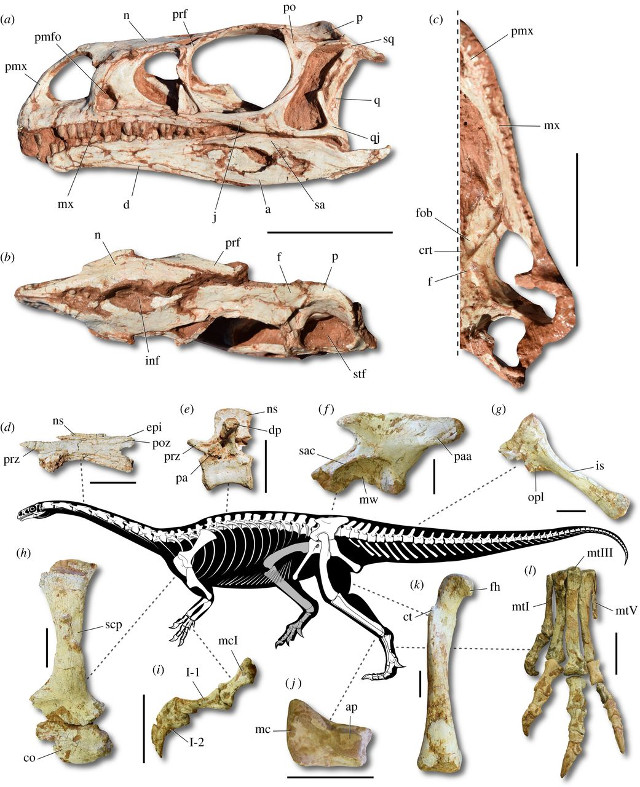 An article published in the journal “Biology Letters” describes the discovery of a dinosaur of the sauropodomorph group that lived in today’s Brazil in the Late Triassic period, about 225 million years ago. Rodrigo Temp Müller and Sérgio Dias-da-Silva of the Universidade Federal de Santa Maria together with Max Cardoso Langer of the Universidade de São Paulo discovered an ancestor of the famous giant long-necked dinosaurs, which was named Macrocollum itaquii. It’s a useful discovery to clarify the evolution of that group of herbivorous dinosaurs.
An article published in the journal “Biology Letters” describes the discovery of a dinosaur of the sauropodomorph group that lived in today’s Brazil in the Late Triassic period, about 225 million years ago. Rodrigo Temp Müller and Sérgio Dias-da-Silva of the Universidade Federal de Santa Maria together with Max Cardoso Langer of the Universidade de São Paulo discovered an ancestor of the famous giant long-necked dinosaurs, which was named Macrocollum itaquii. It’s a useful discovery to clarify the evolution of that group of herbivorous dinosaurs.
Macrocollum itaquii is the oldest long-necked dinosaur discovered, dating back to the Norian, the penultimate division of the Triassic period. Three almost complete skeletons were discovered at the Wachholz site, near the Brazilian city of Agudo, in the State of Rio Grande do Sul. The image (Rodrigo Temp Müller, Sérgio Dias-da-Silva, Max Cardoso Langer / Biology Letters) shows a reconstruction of its skeleton with the available bones shown in white along with various views of its skull and other bones.
The three researchers who discovered and studied Macrocollum itaquii found differences from other sauropodomorphs in its anatomical features. The earliest ancestors of the dinosaurs belonging to that group didn’t have long necks, but this one has it and this suggests that it was already adapted to eating vegetation that grew much higher than the ground, also thanks to the fact that it walked on two legs.
The most obvious difference between Macrocollum itaquii and the giant sauropodomorphs that lived millions of years later is in its size: this animal was about 1.5 meter tall (about 51) for a weight estimated around 90 kg (about 200 lbs.). It looks like a puppy compared to brontosaurus and other long-necked dinosaurs and is significant in the reconstruction of the evolution of gigantism in this group of dinosaurs. An article published in the journal “Nature Ecology & Evolution” described the discovery of another species dating back to the Late Triassic period named Ingentia prima much more massive than Macrocollum itaquii about 20 million years later.
This new species is interesting also because it lived at the time of the Pangaea, the supercontinent that included all the emerged land. The scarcity of fossils from the Late Triassic is one of the problems in the reconstruction of the diversification of sauropodomorphs and their diffusion. The discovery of Macrocollum itaquii offers new information about their history: for example its teeth indicate an omnivorous diet while the later giants called titanosaurs were herbivores.
The discovery of three skeletons that were very close to each other suggests a gregarious behavior of these dinosaurs. This is a confirmation of a theory derived from previous similar discoveries related to other sauropodomorph species and is even more important because it’s the oldest evidence found so far.
The discovery of three almost complete skeletons of Macrocollum itaquii was really a stroke of luck as it allows a precise study of its characteristics. The comparison with other species can be based on certain observations to understand similarities and differences, very useful in the reconstruction of the history of the iconic dinosaurs of the Jurassic period.

